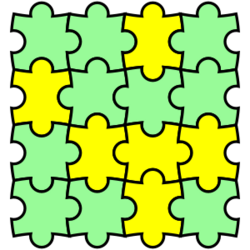Alternating sign matrix
In mathematics, an alternating sign matrix is a square matrix of 0s, 1s, and −1s such that the sum of each row and column is 1 and the nonzero entries in each row and column alternate in sign. These matrices generalize permutation matrices and arise naturally when using Dodgson condensation to compute a determinant.[citation needed] They are also closely related to the six-vertex model with domain wall boundary conditions from statistical mechanics. They were first defined by William Mills, David Robbins, and Howard Rumsey in the former context.
Examples
A permutation matrix is an alternating sign matrix, and an alternating sign matrix is a permutation matrix if and only if no entry equals −1.
An example of an alternating sign matrix that is not a permutation matrix is
- [math]\displaystyle{ \begin{bmatrix} 0&0&1&0\\ 1&0&0&0\\ 0&1&-1&1\\ 0&0&1&0 \end{bmatrix}. }[/math]
Alternating sign matrix theorem
The alternating sign matrix theorem states that the number of [math]\displaystyle{ n\times n }[/math] alternating sign matrices is
- [math]\displaystyle{ \prod_{k=0}^{n-1}\frac{(3k+1)!}{(n+k)!} = \frac{1!\, 4! \,7! \cdots (3n-2)!}{n!\, (n+1)! \cdots (2n-1)!}. }[/math]
The first few terms in this sequence for n = 0, 1, 2, 3, … are
This theorem was first proved by Doron Zeilberger in 1992.[1] In 1995, Greg Kuperberg gave a short proof[2] based on the Yang–Baxter equation for the six-vertex model with domain-wall boundary conditions, that uses a determinant calculation due to Anatoli Izergin.[3] In 2005, a third proof was given by Ilse Fischer using what is called the operator method.[4]
Razumov–Stroganov problem
In 2001, A. Razumov and Y. Stroganov conjectured a connection between O(1) loop model, fully packed loop model (FPL) and ASMs.[5] This conjecture was proved in 2010 by Cantini and Sportiello.[6]
References
- ↑ Zeilberger, Doron, "Proof of the alternating sign matrix conjecture", Electronic Journal of Combinatorics 3 (1996), R13.
- ↑ Kuperberg, Greg, "Another proof of the alternating sign matrix conjecture", International Mathematics Research Notes (1996), 139-150.
- ↑ "Determinant formula for the six-vertex model", A. G. Izergin et al. 1992 J. Phys. A: Math. Gen. 25 4315.
- ↑ Fischer, Ilse (2005). "A new proof of the refined alternating sign matrix theorem". Journal of Combinatorial Theory, Series A 114 (2): 253–264. doi:10.1016/j.jcta.2006.04.004. Bibcode: 2005math......7270F.
- ↑ Razumov, A.V., Stroganov Yu.G., Spin chains and combinatorics, Journal of Physics A, 34 (2001), 3185-3190.
- ↑ L. Cantini and A. Sportiello, Proof of the Razumov-Stroganov conjectureJournal of Combinatorial Theory, Series A, 118 (5), (2011) 1549–1574,
Further reading
- Bressoud, David M., Proofs and Confirmations: The Story of the Alternating Sign Matrix Conjecture, MAA Spectrum, Mathematical Associations of America, Washington, D.C., 1999.ISBN:978-0521666466
- Bressoud, David M. and Propp, James, How the alternating sign matrix conjecture was solved, Notices of the American Mathematical Society, 46 (1999), 637–646.
- Mills, William H., Robbins, David P., and Rumsey, Howard Jr., Proof of the Macdonald conjecture, Inventiones Mathematicae, 66 (1982), 73–87.
- Mills, William H., Robbins, David P., and Rumsey, Howard Jr., Alternating sign matrices and descending plane partitions, Journal of Combinatorial Theory, Series A, 34 (1983), 340–359.
- Propp, James, The many faces of alternating-sign matrices, Discrete Mathematics and Theoretical Computer Science, Special issue on Discrete Models: Combinatorics, Computation, and Geometry (July 2001).
- Razumov, A. V., Stroganov Yu. G., Combinatorial nature of ground state vector of O(1) loop model, Theor. Math. Phys., 138 (2004), 333–337.
- Razumov, A. V., Stroganov Yu. G., O(1) loop model with different boundary conditions and symmetry classes of alternating-sign matrices], Theor. Math. Phys., 142 (2005), 237–243, arXiv:cond-mat/0108103
- Robbins, David P., The story of [math]\displaystyle{ 1, 2, 7, 42, 429, 7436, \dots }[/math], The Mathematical Intelligencer, 13 (2), 12–19 (1991), doi:10.1007/BF03024081.
- Zeilberger, Doron, Proof of the refined alternating sign matrix conjecture, New York Journal of Mathematics 2 (1996), 59–68.
External links
- Alternating sign matrix entry in MathWorld
- Alternating sign matrices entry in the FindStat database
 |


